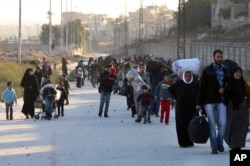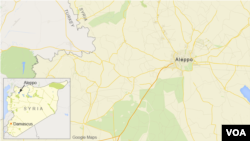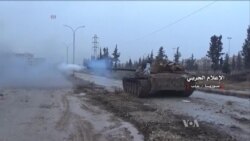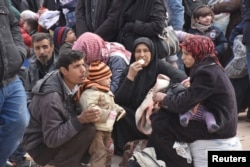Some 31,500 civilians have fled eastern Aleppo since Syrian government forces captured more than one-third of the rebel-held besieged territory this week.
The United Nations reports 18,000 civilians have fled to Jibreen, an industrial zone in eastern Aleppo; 8,500 have gone to Kurdish-inhabited Sheikh Maqsood, north of the city; and 5,000 have been displaced inside the besieged area.
Jens Laerke, spokesman for the U.N. Office for the Coordination of Humanitarian Affairs (OCHA), said some people fleeing eastern Aleppo reportedly were experiencing difficulties and, in some cases, putting their lives in danger.
“We have reports that some men and boys have been detained when crossing into government-controlled areas, and some internally displaced people have reported that they have had their documents confiscated upon crossing into government of Syria-controlled areas,” he said.
“We also have reports that some people trying to move have been shot at, resulting in death and injuries.”
Laerke said rebel groups also reportedly “have sought to prevent people from leaving eastern Aleppo.”
Council criticized
In New York, U.N. Secretary-General Ban Ki-moon criticized divisiveness among regional powers and the Security Council for failing to find a political solution to end the nearly six-year-old conflict, and he called again for a cessation of hostilities.
"We have been trying to make a political deal. Unfortunately, all this divisiveness of politicians has led us to this very tragic situation," he told VOA in an interview Friday.
The U.N. Children’s Fund reports that children constitute about 60 percent, or nearly 19,000, of those displaced by the recent fighting.
“The staff who met with children over the last few days noted that you could see the loss and horror in their eyes,” said Christophe Boulierac, spokesman for UNICEF.
“Let us keep in mind that every single child under the age of 5 in Syria has known nothing but war.”
Boulierac said there was “a race against time” to provide immediate and sustained assistance for the children and their families. As part of this effort, he said, UNICEF has installed 10 water storage tanks at three locations, including the Jibreen area, “to provide access to safe water and improved sanitation facilities.”
He told VOA that UNICEF and partners were continuing to run a lifesaving vaccination campaign, noting that “many children have missed out on critical routine vaccinations, and that clearly endangers them for preventable diseases.”
Before the conflict began more than five years ago, about 95 percent of Syria’s children were immunized against diseases such as measles, polio and respiratory infections. The coverage rate reportedly has since dropped to around 20 percent.
As civilians continue to flee eastern Aleppo, the displacement problem in the western government-controlled part of the city has been growing. The United Nations reports 400,000 people have now been displaced in western Aleppo.
Adrian Edwards, spokesman for the U.N. refugee agency, said temperatures in the region were dropping quickly, so providing shelter to this large population of destitute people was now the most urgent need.
“Many of those who have fled the eastern districts are present in unfinished or partly destroyed buildings. Unsanitary conditions, overcrowding — these are already challenges in a congested city with few open spaces,” Edwards said.
He said his agency and partners were working to rehabilitate buildings in Jibreen, in government-controlled southwestern Aleppo and other areas where the displaced are present. He said this was crucial, because some of the buildings “are now at risk of collapse.”
Edwards said that the UNHCR had largely shifted its humanitarian operation to government-controlled western Aleppo. He said the reason was that his agency was unable to reach the many thousands without food, water and shelter in eastern Aleppo as temperatures drop and fighting rages.
Rebel-controlled eastern Aleppo has been besieged for nearly five months. The Syrian government of President Bashar al-Assad has not allowed humanitarian aid into the city since early July, nor has it given the United Nations permission to evacuate hundreds of seriously wounded and sick patients in urgent need of medical care.
The Russian Federation has proposed opening four corridors so these humanitarian operations can take place. Russia has questioned why the U.N. has not taken it up on its proposal for safe passage in and out of the city.
In response, OCHA spokesman Jens Laerke told VOA that the U.N. would discuss with the Russian Federation “how we may use these corridors to evacuate people, especially the sick and wounded, and use them to get medical supplies and other relief in."
“As with any humanitarian corridor, it is fundamental that all parties to the conflict guarantee safe use.” He said the most urgent priority was to get access and reach everybody in need.
VOA's Margaret Besheer at the United Nations contributed to this report.













